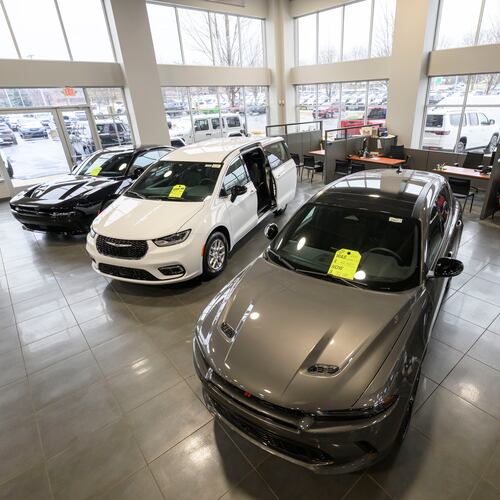Alan Cablik led the way from the one-car garage up some stairs and out onto a backyard large enough to walk a dog – so long as it’s only a couple steps – then back into the house and up a flight of stairs to the kitchen, living room and dining room.
Then, more steps.
“I had a workman lose 10 pounds working on these,” he said, heading up toward the third floor where he pointed out the two bedrooms.
It's a townhome, with 1,500 square feet of living space. It's 12 feet wide and four stories high, one of 16 built by Cablik Enterprises on Memorial Drive at the south end of Kirkwood. It's listed at $260,000, half the price of the other Cablik townhomes nearby. But then, it's also half the width.
“We took our usual design and just cut it in half,” said Cablik, the company president.
It’s not a gimmick, but a gamble on economics and demography. Maybe it’s the future of affordable home ownership in Atlanta.
As the region recovered from the Great Recession, hiring surged and young professionals flowed into Atlanta to fill them. Unlike sprawl-ready baby boomers of a generation ago, millennials mostly wanted to live intown, where the available housing was mostly apartments and condos.
Many who wanted to buy houses were out of luck as Atlanta land prices soared. Even quarter-acre properties now sell in parts of Midtown for more than $500,000 just for the land or a house that is going to be torn down. To make a profit, developers have put up ever-larger and more-expensive houses in areas where zoning requires single-family homes.
Builders have increasingly used townhomes elsewhere to fit more units on less space. The share of homes in Atlanta that were townhomes rose in the past two years from 5 percent to 9 percent, said Skylar Olsen, senior economist for Zillow, the online housing database company.
But with the price of land still rising faster than incomes, townhomes are no longer so affordable an alternative. Atlanta currently has more than 200 townhomes listed for sale at $500,000 more, nearly three times as many as are listed below $300,000, according to Zillow.
Many of the cheaper townhomes are older construction or in less-popular neighborhoods. Few of those are in millennial hotbeds like Kirkwood, which is close to pedestrian-friendly magnets like the Beltline and Krog Street Market.
And Cablik’s tall, narrow townhomes are targeting millennials who - unlike many boomers - are still young enough to tackle all those stairs if that’s the price for affording a house.
"We don't really have a lot of product in the new home industry to go after these guys. Yet," said John Hunt, principal at MarketNsight, a housing research and consulting company. "We have to re-think our 40-year-old ideas about new construction."
Millennials are now the largest generational cohort in the U.S. workforce – more than 80 million strong - but their home ownership rate has been chronically below that of previous generations. Still unanswered: Is that because of a cultural shift as young people raised on services like Lyft prefer to rent instead of buy, or is it because they can’t afford to buy?
Builders like Cablik are betting that it’s all about the Benjamins: prices are just too high.
Slightly more than half of the millennials surveyed in Georgia say a poor credit score is the biggest obstacle to buying a home, according to the Country Financial Group, which surveyed 500 Georgians in early February. Nearly one in three said they didn't have enough money for a down payment.
There are condos, of course. They offer ownership, but not everyone wants neighbors below or above or both. Even the narrowest of townhomes gives the owner a roof and a little land, perhaps even parking.
Katie Williams, 24, an online analyst for a large Atlanta company, had been looking for a home with her boyfriend. They saved money by sharing a townhome with a roommate, but still could only afford something under $200,000.
“I have a lot of student loans and I have a car loan too,” Williams said.
They found a three-bedroom that fit the bill, a 1,340 square-foot townhome in Smyrna, made an offer right away and bought it.
"It's about a mile from the Battery," said Williams. "We can walk over there for dinner or lunch. And I am close enough to work that I can bike there."
The increasingly city-like atmosphere of Chamblee drew Amy Hall.
“I don’t want to go too far from work,” said Hall, 36, who has a job with a corporate foundation. “I don’t want to go beyond my means. I don’t want to rent. I don’t want to have people above and below me. My range was $175,000 to $225,000.”
In October, she bought a two-story, two-bedroom townhome in Chamblee for $210,000.
There is a shrinking pool of low-priced townhomes, though, and many prospective young buyers don’t want to move out to the suburbs or exurbs for something they can afford.
Megan Lyons, agent for Re/Max Around Atlanta Realty, said builders are still not quite on the bandwagon. "These are young professionals, wanting to stay in the city, but prices are just going crazy," she said. "A lot of them end up coming out of the city because they just give up."
Steve Brock, president of Brock Built, a 35-year-old company that has constructed 1,300 homes, does build townhomes – but they are generally 22 feet wide or more. Most are listed for $500,000 or more.
The “narrow homes” of the Cablik project might be ahead of the curve, he said. “What we have seen is a trend toward this – I would call it experimental at this point.”
It’s too early to tell if such townhomes will take root. All those flights of stairs getting from kitchen to bedroom to roof deck and all the way down to the ground again to walk the dog or use the car?
But it’s not the only experiment underway around the city.
One notion is single-family homes built separate but so close together that cooks who get stymied at dinnertime could swap ingredients through the windows.
Van Hardimon, a local builder, is putting up houses four feet apart – seven of them on one third of an acre near the corner of Perry Boulevard and Hollywood Road in Northwest Atlanta. The first of them is listed at $319,900 – far cheaper than most new homes on the northside, which are typically bigger houses on larger lots.
“This is our first time doing this, but we have no doubts whatsoever about the market,” Hardimon said. “The market is definitely looking for something like this.”
About the Author
Keep Reading
The Latest
Featured




